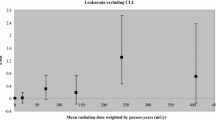Abstract
The National Academy of Science’s 1956 study on the Biological Effects of Atomic Radiation (BEAR) was designed to provide an objective analysis to assess conflicting statements by leading geneticists and by officials in the Atomic Energy Commission. Largely because of its status as a detached, non-governmental evaluation by eminent scientists, no studies have had a broader impact on the development of biological thinking in regard to nuclear policies. This paper demonstrates that despite the first BEAR study’s reputation as an objective and independent study, it was the product of careful negotiation between Academy scientists, the Atomic Energy Commission, and Britain’s Medical Research Council. This paper also reveals the fragility of the consensus that produced the Academy’s report, the range of political uses of the report, and the subsequent disaffection of the scientists who took part in it.
Similar content being viewed by others
References
Atomic Expert Challenges Stevenson. Los Angeles Times (18 Oct 1956): 2
Atomic Waste No Problem Yet, Strauss Says at Generator Site. New York Times (May 8, 1956): 43
President’s Text on Nuclear Action. Los Angeles Times (24 Oct 1956), 8
Genetic Effects of Atomic Radiation. Science New Series 123: 3209 (29 Jun 1956), 1157–1164
Allen Garland E. and and Thomas Hunt Morgan (1978). The Man and His Science. Princeton University Press, Princeton
Beadle, George, W. 1955. “H. J. Muller and the Geneva Conference.” Science New Series 122: 3174, 818
Beatty John (1987). Weighing the Risks: Stalemate in the Classical/Balance Controversy. Journal of the History of Biology 20(3): 289–319
Carlson Elof Axel (1981). Genes, Radiation and Society: The Life and Work of H. J. Muller. Cornell University Press, Ithaca
Crow James, F. (1987). Muller, Dobzhansky and Overdominance. Journal of the History of Biology 20(3): 351–380
Divine Robert, A (1978). Blowing on the Wind: the Nuclear Test Ban Debate. Oxford University Press, New York
Glennon, John P., (ed.). 1990. Foreign Relations of the United States, 1955–1957 Vol. XX: Regulation of Armaments; Atomic Energy. Washington, DC: Government Printing Office
Green, Francis, H. K. 1952. “The Constitution and Functions of the United Kingdom Medical Research Council.” Science, New Series 116, 3005: 99–105
Hacker Barton, C (1994). Elements of Controversy: The Atomic Energy Commission and Radiation Safety in Nuclear Testing. University of California Press, Berkeley, 1947–1974
Kay Lily, E (1993). The Molecular Vision of Life: Caltech, the Rockefeller Foundation and the Rise of the New Biology. Oxford University Press, New York
Kopp Carolyn, (1979). The Origins of the American Scientific Debate over Fallout Hazards. Social Studies of Science 9(4): 403–422
Lapp Ralph, E (1958). The Voyage of the Lucky Dragon. Harper, New York
Lindee Susan, M (1994). Suffering Made Real: American Science and the Survivors at Hiroshima. University of Chicago Press, Chicago
Muller, Hermann, J. 1955. “Genetic Damage Produced by Radiation.” Science New Series 121, 3155: 837–840
Neel, James, V. 1998. “Genetic Studies at the Atomic Bomb Casualty Commission – Radiation Effects Research Foundation: 1946–1997.” Proceedings of the National Academy of Sciences of the United States of America 95(10): 5432–5436
Neel James, V (1994). Physician to the Gene Pool: Genetic Lessons and Other Stories. J. Wiley, New York
Paul Diane, B. (1987). Our Load of Mutations’ Revisited. Journal of the History of Biology 20(3): 321–335
Pfau Richard (1984). No Sacrifice Too Great: The Life of Lewis L. Strauss. University Press of Virginia, Charlottesville
Putnam Frank, W. (1998). The Atomic Bomb Casualty Commission in Retrospect. Proceedings of the National Academy of Sciences of the United States of America 95(10): 5426–5431
Sturtevant A. H (1965). A History of Genetics. Harper & Row, New York
Sturtevant, A. H. 1954. “Social Implications of the Genetics of Man.” Science New Series 120: 3115, 405–407
Samuel J (2000). Permissible Dose: A History of Radiation Protection in the Twentieth Century. University of California Press, Berkeley
Author information
Authors and Affiliations
Corresponding author
Rights and permissions
About this article
Cite this article
Hamblin, J.D. ‘A Dispassionate and Objective Effort:’ Negotiating the First Study on the Biological Effects of Atomic Radiation. J Hist Biol 40, 147–177 (2007). https://doi.org/10.1007/s10739-005-6531-8
Published:
Issue Date:
DOI: https://doi.org/10.1007/s10739-005-6531-8



